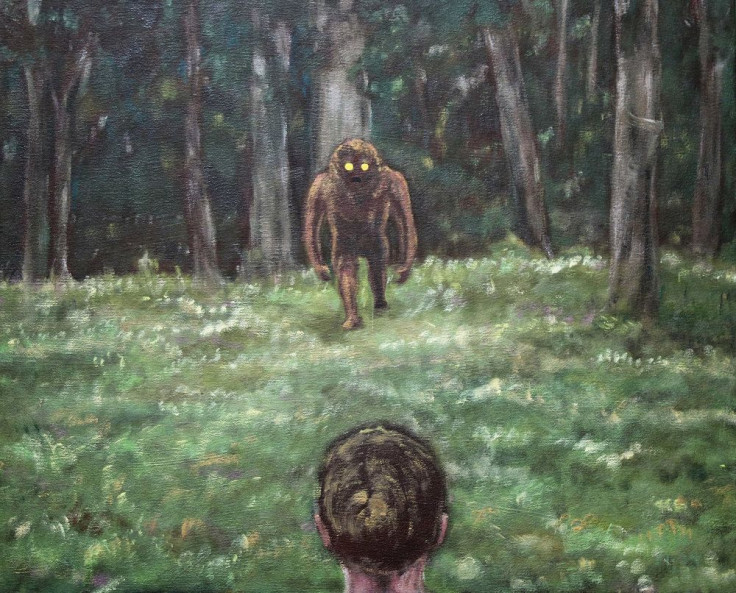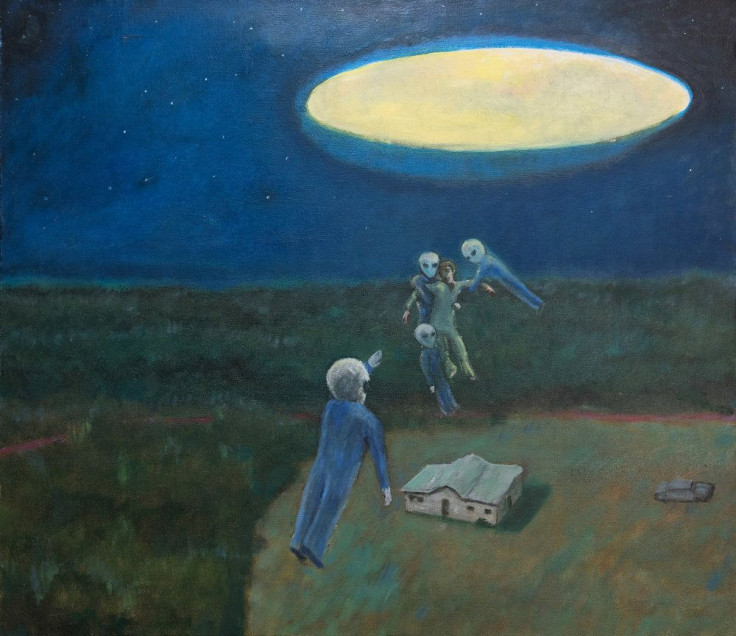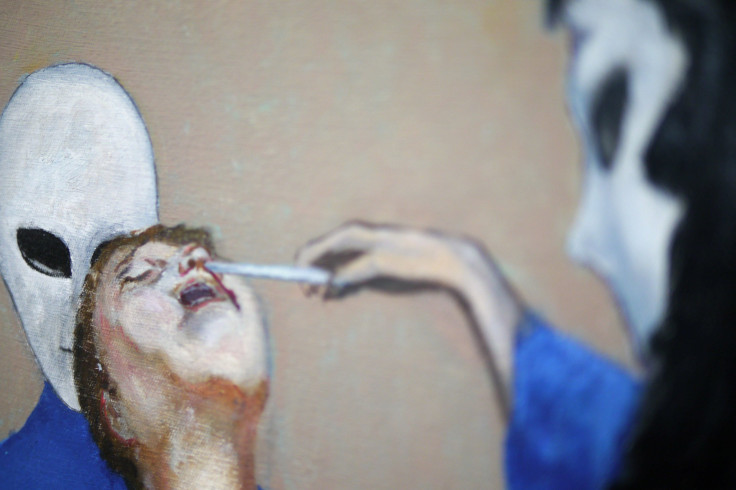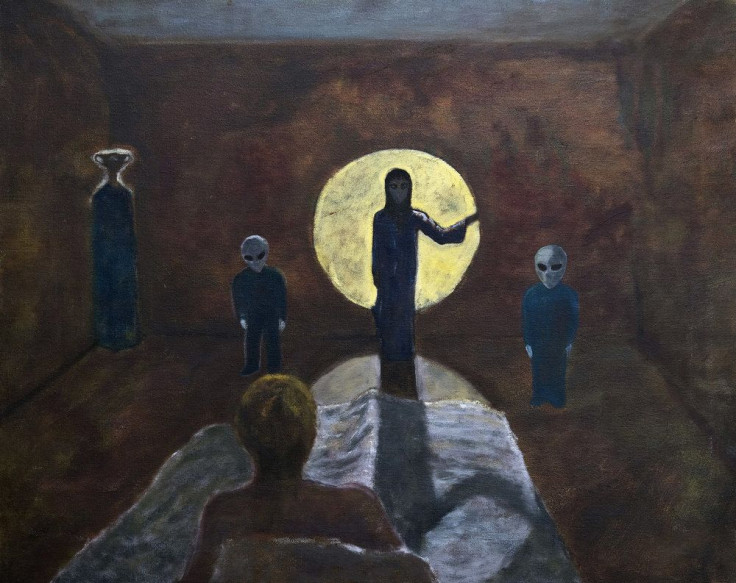New documentary Love and Saucers opens on its subject, painter David Huggins, in his New Jersey studio. Behind him is a painting of a pale woman, her angular face framed by black hair. Her immense, unhuman eyes are closed. “Well, when I was 17 I lost my virginity to a female extraterrestrial,” Huggins says. “That’s all I can say about it.”
When Huggins was eight, growing up in rural Georgia, he first encountered the beings that would upend his whole life. The very first he described to Player.One as “a little hairy guy.”
“He scared the hell out of me,” Huggins said. But then something strange happened. “It was weird. I was looking at him and then suddenly I see myself in his eyes. I’m looking at me.” In a lifetime of interactions with beings both mysterious and often frightening in appearance, this was the only time Huggins experienced anything like that.
For most of us, the mere idea of alien abduction is terrifying. Imagine it: you wake in the middle of the night and find yourself paralyzed. Inhuman beings surround you, take you away, force invasive procedures upon you. You are returned with lost time, memories broken into fragments of fear, uncertainty and shame. But Huggins’ experiences, explored at length in the Love and Saucers, are different and more positive than most. Exactly how can be seen in his very first encounter, with the “little hairy guy.”

Philosopher Arthur Schopenhauer once described a burrow full of porcupines, huddling together for warmth, driven apart again and again by the spines of their fellows, until they find the exact right combination of distance and intimacy to share as much warmth as they are able. The social lives of humans exist in this same precarious state, what Neon Genesis Evangelion calls the “Hedgehog’s Dilemma”: we crave intimacy but are unable to fully share it, afraid that we will be pricked. We live only half-satisfied, unable to fully experience each other, kept at a distance by social norms and fear. Huggins’ first encounter with a non-human being afforded him something only fleetingly glimpsed in human relationships: seeing himself through the eyes of another. Though Huggins shares many more fantastical meetings in Love and Saucers, at the core is an uncanny, even holy, brush with consciousnesses outside normal human experience.
The encounters — Huggins estimates he’s had over a hundred in his life — escalated quickly after the little hairy guy. The next visitor was a “giant, insect-like being” resembling a praying mantis. This second meeting was the most frightened he had ever been. “He scared me like everything,” Huggins told me, especially when the gangling creature began spraying a bluish-gray liquid, which evaporated almost as soon as it hit the ground.
Huggins shares all of his stories as matter-of-factly, both in Love and Saucers and in conversation with me, describing extravagantly unbelievable memories with a frankness that makes it impossible to truly disbelieve. There’s certainty to his recollections, but also humility: an unwillingness to extrapolate, evangelize or adorn. Believing Huggins doesn’t require upending your conception of the universe, only accepting that he has touched something strange and amazing — supernatural or other-dimensional, mystic, anomalous or psychological — something fantastical.
Just as astonishing as his personal recollections are Huggins’ oil paintings. He explores his past on canvas, examining his own memories of abduction, communion and sexual awakening, bringing to them an emotional and erotic resonance absent his more straightforward remembrances.
Earnest self-examination is apparent in his art. Some paintings are of alien subjects alone, but many feature David at various stages of his life. In some he’s terrified, like in his painting “Floating Up”: his arms and legs braced by greys, mouth open with horror, a young David is drawn up into a ovoid of pure light, his family home far below. In another he sucks at an alien woman’s breast, his expression both grateful and a little bewildered, the alien smiling, both infantilizing and indulging.

“He’s clearly working through his experiences — his suffering and his joy — all at the same time,” Dr. Jeffrey J. Kripal, in the Department of Philosophy and Religious Thought at Rice University, says in Love and Saucers, where he compares Huggins’ experiences to erotic, mystic experiences throughout human history. “When a human being encounters the sacred, it’s a terrifying experience. And it’s an ecstatic experience. You are being split open.”
Throughout his journey, Huggins had a constant companion: his alien lover, Crescent. They met during his first abduction. It began with a cadre of greys, who dropped from the sky in blue tunics and came to his bedside. They took him into their craft, where an alien woman inserted a long rod into David’s nose. When he complained about the pain, she touched his face and took the pain away. That was how he met Crescent. Years later, Crescent would return to take David’s virginity in an encounter that was both erotic and painful.

When Huggins was 19, he left Georgia for New York. “They followed me, they knew exactly where I was,” he said. Crescent continued to visit, entering his apartment at night through a portal in his wall. Separated from his childhood encounters in a new environment, Huggins struggled all over again to understand his strange experiences. “I would wake up in the morning and I would hear this voice say, ‘We’ll be back tonight,’ and I would forget it. This would go on for months and months. I would hear those words, but then I would forget. You have no idea what I was going through those days: ‘They’re real. No they’re not. She’s real. No she’s not.’”
So he bought her flowers, pink cyclamens. “If she’s real, the plant is for her. If not, I’ll do a painting or pastel of it,” he rationalized. The next morning the flowers were gone, and Huggins’ doubts with them.
Crescent’s return that evening began to feel almost like a date. “I hurried home, cleaned the apartment, then debated how to present myself,” Huggins said. “Do I wear a suit?”
Near midnight, Huggins took off his clothes and got into bed. Just after, they entered: Crescent, a mantis being and a couple of the greys. “She came over to me and she gets on top of me and we have sex,” Huggins describes. “It was quite pleasant. I remember her laying down on top of me and I hear this nice purring sound, almost like a cat.”

No matter how strange, it’s hard not to wonder what the emotional or romantic content of such a coupling meant for Crescent. I asked whether their relationship felt transactional. Was he just being used for his sperm? Or did they have a relationship of the interpersonal sort, an exchange of personalities as well as bodies?
“At the beginning it was practical, especially with Crescent,” Huggins said. “And then it became far more pleasurable with her. I can’t say that about the others. With Crescent, at first it was all just performance, there was no emotion at all.”
They mostly communicated by thoughts, “but I think there were a few times where she spoke English,” Huggins said. “She’s very nice, I’ve never had a problem with her. She’s very gentle and quite pleasant really.”
Not every encounter Huggins had felt so intimate. Over the years, David would meet many children — his and Crescent’s. Occasionally, the beings would make clear just how essential breeding was to their relationship with him. Huggins met dozens of representatives of, by my count, four different categories or species of alien beings, but one figure stood out: a tall being with a nodule, roughly the size and shape of a topknot, protruding from his head. “He was like an overseer,” Huggins said. “ I didn’t see him all that often, I think I saw him maybe three or four times and that was it.”
In one encounter, the overseer brought Huggins to a group of alien women, like Crescent, and told him, “‘You will give all these women babies.’”
“It just totally flipped me out. There’s no way I can make out with 30 or 40 women, there’s just no way. I was very frightened by that,” Huggins said. “He just laughed.” The overseer led Huggins into a room, where he was expected to ejaculate into a bowl as one of the mantis beings watched.
“And I remember saying, ‘You want me to make love to a bowl, no hugging or kissing?’ And I like hugging and kissing. And two women came near me and started hugging and stroking my body and I ejaculated into the container,” he explained.
Though sex was a constant in the decades-long relationship Huggins shared with Crescent, the overseer, the hairy little guy, the mantids and the greys, his paintings reveal all varieties of minor intimacies. One painting depicts Huggins in a maroon room, seated on a low bench, cradling a baby in his arms. Replace the towering women with alien faces and the giant praying mantises, imagine some other vista than stars out the round window, and the scene begins to look commonplace. David’s face is calm, the baby sleeps in his arms. A woman bends down to join him, her straight black hair more visible than her colorless, extraterrestrial face. The moment looks gentle, almost familial.
And even if the overseer was largely indifferent to Huggins’ emotional needs, there were incidents where these inhuman beings afforded him entirely human indulgences. There was one visit where David believed the baby in his arms — his baby — had died. He grew distraught and, frightened, pushed the baby away. It fell to the floor. Days later, recounting the incident, he had something approaching a panic attack. “I just flipped out and was like ‘No, no, no, no, no, no,’ and Crescent and two very large women come over to me and hold me to the floor and Crescent said, ‘David, what is the matter?’” They brought him the baby, still very much alive. David kissed its forehead.
Still, much remained profoundly alien and alienating. One frightening painting depicts a grey stuffed in a transparent envelope, its mouth open in an expression that might be panic, its hands pressed against the clear material. “All I can tell you is that one of the little greys handed me a packaged alien,” Huggins said when I asked about it. “I was holding it in my hands and suddenly, for some reason, his eyes opened and he was tapping on the inside of this plastic envelope. And I got scared and handed it back to the little grey and he put it away.”
In another encounter, a grey handed him a blue book. “I was looking at the cover of the book and I saw this glint of light in it. And I opened the book up and the pages are sparkling white, brilliant white, and there are symbols flashing on and off on the pages,” Huggins said. “The only symbol I remember is a circle with a cross in between it, almost like the crosshairs of a telescopic lens.”
Other memories Huggins has recovered aren’t alien, but something else entirely. He once had a vision of floating through a tunnel, only to encounter a very large bird that burst into flames, then collapsed into a pile of ash. “And out of that ash came a long, dark caterpillar or worm,” he said. A friend later connected his vision to the phoenix, though Huggins hadn’t been familiar with the mythical bird.
“The whole history of religions is essentially about weird beings coming from the sky and doing strange things to human beings,” Kripal says in the documentary. “Historically, those events or encounters have been framed as angels or demons, or gods or goddesses, or what have you. But in the modern, sort of secular world we live in, they get framed as science fiction.”
Is it possible alien greys and mantids — extraterrestrial “types” many other abductees have seen — became the interpretive filter through which Huggins explained even stranger and inexplicable ecstatic experiences to himself? Would the beings Huggins met have been interpreted as angels or demons or gods or goddesses in some other, past context?
“I am using the word extraterrestrial,” Huggins told Player.One. “I have no idea where they’re from. I just can’t tell you. I really don’t know.”
In 1819, Romantic poet and painter William Blake held a séance with painter and astrologer John Varley. Their goal: to summon someone from history or mythology for a series of portraits that became known as “ Visionary Heads.” But this time, Blake didn’t see Merlin, Voltaire or Caratacus, but instead a hulking brute with a sawtooth spine, its tongue sticking out, gaze fixed on a bowl of blood. The thing was immortalized in one of Blake’s smallest paintings (an intentional effort to reduce its power), The Ghost of a Flea. The Romantic poets chased what they called “the sublime,” a holy experience of the infinite capable of both enlightening and terrifying. But for Blake, prone to visions his whole life, the sublime often appeared literally. It is rare to touch the sublime today. Few even search for it anymore. Even fewer have it reach out and grab them, as it did Huggins.
Huggins, a painter just like Blake, didn’t need a séance, but did find a similar trigger to his memories, in 1987. Haunted by fragmented recollections from his childhood, Huggins eventually sought out a book by Budd Hopkins, an alien abduction researcher and founder of abduction support groups. In Hopkins’ book, Intruders: The Incredible Visitations at Copley Woods, Huggins discovered encounters, some familiar, some dissimilar to his own.
“I started remembering episodes and memories in my life,” Huggins said. “I had forgotten them. And then they came flooding back.”
The abductions continued after Huggins’ memories began returning to him, but he had finally found the capacity to understand and explore them. In fact, he began his paintings with the approval of the mysterious overseer. “My impression is that they want to be known about,” Huggins told Player.One. “And that’s all I can say about that.”
Did they like his paintings? “I think they did.”
Love and Saucers is now available for VOD streaming on iTunes, Amazon, Vimeo, Google Play and YouTube.


















